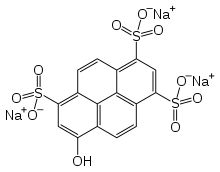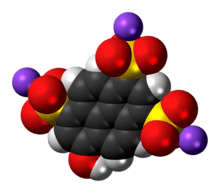Pyranine
 | |
 | |
| Names | |
|---|---|
| IUPAC name
trisodium 8-hydroxypyrene-1,3,6-trisulfonate | |
| Other names
8-hydroxypyrene-1,3,6-trisulfonic acid, Solvent Green 7, HPTS, sulfonated hydroxy pyrene trisodium salt | |
| Identifiers | |
3D model (JSmol) |
|
| ECHA InfoCard | 100.026.166 |
| EC Number | 228-783-6 |
PubChem CID |
|
| |
| Properties | |
| C16H7Na3O10S3 | |
| Molar mass | 524.37 |
| Appearance | yellow-green crystalline powder |
| Soluble | |
| Hazards | |
| Main hazards | XI |
| R-phrases (outdated) | 36/37/38 |
| S-phrases (outdated) | 26-36 |
Except where otherwise noted, data are given for materials in their standard state (at 25 °C [77 °F], 100 kPa). | |
| Infobox references | |
Pyranine is a hydrophilic, pH-sensitive fluorescent dye from the group of chemicals known as arylsulfonates.[1][2] Pyranine is soluble in water and has applications as a coloring agent, biological stain, optical detecting reagent, and a pH indicator.[3][4] One example would be the measurement of intracellular pH.[5] Pyranine is also found in yellow highlighters, giving them their characteristic fluorescence and bright yellow-green colour. It is also found in some types of soap.[6]
Synthesis
It is synthesized from pyrenetetrasulfonic acid and a solution of sodium hydroxide in water under reflux.[7] The trisodium salt crystallizes as yellow needles when adding an aqueous solution of sodium chloride.
See also
External links
References
- ↑ "chem industry entry".
- ↑ "Comparative Toxicogenomics Database entry".
- ↑ "chemical land 21 entry".
- ↑ "Sci-Toys entry".
- ↑ "Loading pyranine via purinergic receptors Bing by Siang Gan".
- ↑ http://householdproducts.nlm.nih.gov/cgi-bin/household/brands?tbl=chem&id=218
- ↑ Tietze, Ernst; Bayer, Otto (1939). "Die Sulfosäuren des Pyrens und ihre Abkömmlinge". Justus Liebig's Annalen der Chemie. 540 (1): 189–210. doi:10.1002/jlac.19395400113. ISSN 0075-4617.
This article is issued from
Wikipedia.
The text is licensed under Creative Commons - Attribution - Sharealike.
Additional terms may apply for the media files.